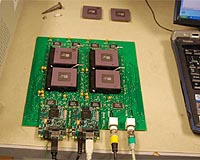 |
Delft, Netherlands (SPX) Dec 29, 2010 Scientists from the Kavli Institute of Nanoscience at Delft University of Technology and Eindhoven University of Technology have succeeded in controlling the building blocks of a future super-fast quantum computer. They are now able to manipulate these building blocks (qubits) with electrical rather than magnetic fields, as has been the common practice up till now. They have also been able to embed these qubits into semiconductor nanowires. The scientists' findings have been published in the current issue of the science journal Nature.
Spin This is achieved by using the spin of an electron, which is generated by spinning the electron on its axis. The electron can spin in two directions (representing the '0' state and the '1' state).
Electrical instead of magnetic This form of control has major advantages, as Leo Kouwenhoven, scientist at the Kavli Institute of Nanoscience at TU Delft, points out: "These spin-orbit qubits combine the best of both worlds. They employ the advantages of both electronic control and information storage in the electron spin."
Nanowires Kouwenhoven: "These nanowires are being increasingly used as convenient building blocks in nanoelectronics. Nanowires are an excellent platform for quantum information processing, among other applications."
Share This Article With Planet Earth
Related Links Delft University of Technology Computer Chip Architecture, Technology and Manufacture Nano Technology News From SpaceMart.com
 S.Korea's Hynix says chip price slump will hit Q4 profit
S.Korea's Hynix says chip price slump will hit Q4 profitSeoul (AFP) Dec 21, 2010 South Korea's Hynix Semiconductor says it expects computer memory-chip prices to fall further early next year and hit its fourth-quarter results this year. "Chip prices remained strong until the first half of this year, but they dropped sharply, especially during the fourth quarter," chief executive O.C. Kwon told The Wall Street Journal in an interview. "Due to the sharper than expecte ... read more |
|
| The content herein, unless otherwise known to be public domain, are Copyright 1995-2010 - SpaceDaily. AFP and UPI Wire Stories are copyright Agence France-Presse and United Press International. ESA Portal Reports are copyright European Space Agency. All NASA sourced material is public domain. Additional copyrights may apply in whole or part to other bona fide parties. Advertising does not imply endorsement,agreement or approval of any opinions, statements or information provided by SpaceDaily on any Web page published or hosted by SpaceDaily. Privacy Statement |